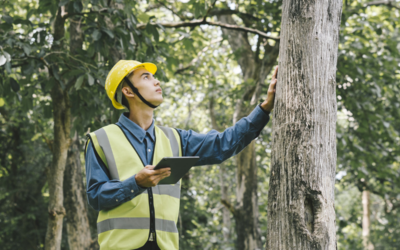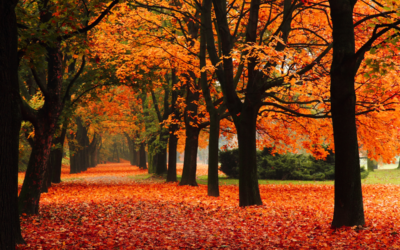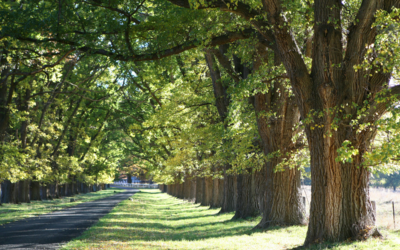Trees, shrubs, and grasses have many enemies, from insects and animals to biological threats. While damage from browsing animals such as deer and elk are usually easy to spot, microscopic pests can be hard to detect until they’ve become widespread. Here are a few examples and the signs to look out for:
Anthracnose
Anthracnose affects a wide variety of hardwoods including oak, maple, sycamore, ash, walnut, and dogwood. Symptoms vary with species, but in general the most obvious symptoms are leaf lesions that appear in the spring and expand throughout the summer. Lesions often begin as pale green or greenish-grey blotches.
Powdery Mildew
Powdery mildew is caused by many different fungi and can infect a wide variety of trees. Symptoms usually appear late in the growing season during periods of high relative humidity. It causes stunting and distortion of leaves, buds, growing tips, and fruit. The presence of white to gray fungal growth over leaf surfaces is the most common sign of the disease. Powdery mildew begins as circular, powdery white spots and expands to coat the entire leaf surface. In most cases the fungus can be removed by rubbing the leaves.
Leaf Rust
Leaf rust commonly affects aspen and cottonwood trees. It rarely causes serious damage since it develops late in the summer or fall and seldom causes early leaf loss. Leaf rust is easy to recognize by the small, yellow-orange pustules that are scattered on the lower leaf surfaces. Leaf rust overwinters on fallen cottonwood or aspen leaves, and its spores infect evergreen needles where they cause little damage. The spores are then blown to aspen or cottonwood leaves where they can multiply rapidly throughout the summer. Several years of heavy infections can cause some growth losses, especially on younger trees. Fallen infected leaves shelter the fungus until the next year’s disease cycle.
Leaf Blight
Leaf blight is a bacterial disease that attacks more than 100 species of plants in the Rosacea family including apples, hawthorns, pears and mountain ash. It can also occur in stone fruits such as peach, cherry, and plum. Symptoms usually appear in spring when flowers shrivel and turn black instead of developing into fruit. Unchecked, leaf blight can kill a tree.
Bacterial Leaf Scorch
Bacterial leaf scorch infects a tree’s water-conducting tissue. Trees affected include maple, dogwood, sycamore, plum, oak, and elm. The bacteria are able to survive year to year in the tree’s vascular system. Symptoms resemble those of drought. Leaf edges turn red or yellow before wilting and turning brown.
Marssonina Leaf Spot
Marssonina leaf spots are the most common fungal foliage disease on aspen and cottonwoods in Colorado. The spots are dark brown flecks, often with yellow halos. They may have white spots in the center when the first emerge. On severely infected leaves, several spots may fuse to form large black dead patches in late summer. Spots also may develop on leaf petioles and succulent new shoots. Marssonina survives the winter on fallen infected leaves. As it warms, the fungus produces windblown spores that infect emerging leaves. Heavy infections are noticeable later in the season and cause premature leaf loss.
Aspen Ink Spot
Aspen Ink Spot is found mainly in the mountains of Colorado. The first symptoms of ink spot appear in late spring to early summer as tan to brown areas on the upper leaf surfaces. Concentric, discolored ring patterns become visible later in the season and become small, dark masses of fungal material that may fall off, leaving a hole in the leaf. The fungus overwinters in fallen leaves and produces spores that are spread by wind and splashes of rain or sprinklers.
Septoria Leaf Spot
Septoria is a common fungal disease on cottonwoods and occasionally aspen in urban areas. Their appearance can vary by tree species, but typically begins with small brown and black leaf spots that can coalesce into larger areas. It can also cause cankers on twigs and stems. It spreads spores by wind and can cause premature leaf loss on infected trees.
If a tree loses its leaves early in the season, it may grow new ones and its health is not seriously affected. If it loses them in midsummer, however, growing new leaves may prevent the tree from fully hardening off before cold weather and reduce the amount of stored food. This leads to increased danger of frost damage, reduced growth, and predisposition to other diseases or insects. If the tree loses its leaves late in the season, it will not grow new ones or lose much vigor.
The best way to keep your landscape looking great is to tackle problems as soon as they appear. To reduce future disease problems, rake up and dispose of leaves and prune out branches with cankers. Water trees early in the day so the leaves can dry out and avoid wetting leaves with sprinkler spray.
Timing of fungicide application if needed to prevent infections is critical. To properly diagnose and treat a pest or disease problem, contact a professional arborist or your county extension office. Colorado residents can find a list of extension offices on the Colorado State University website.
Donovan Arborists offers complete tree and lawn care services. We’re always happy to give free estimates to homeowners and property managers for any services they may need.



